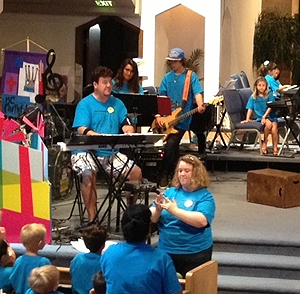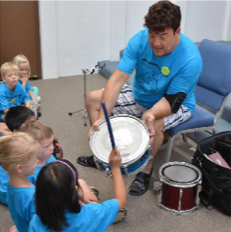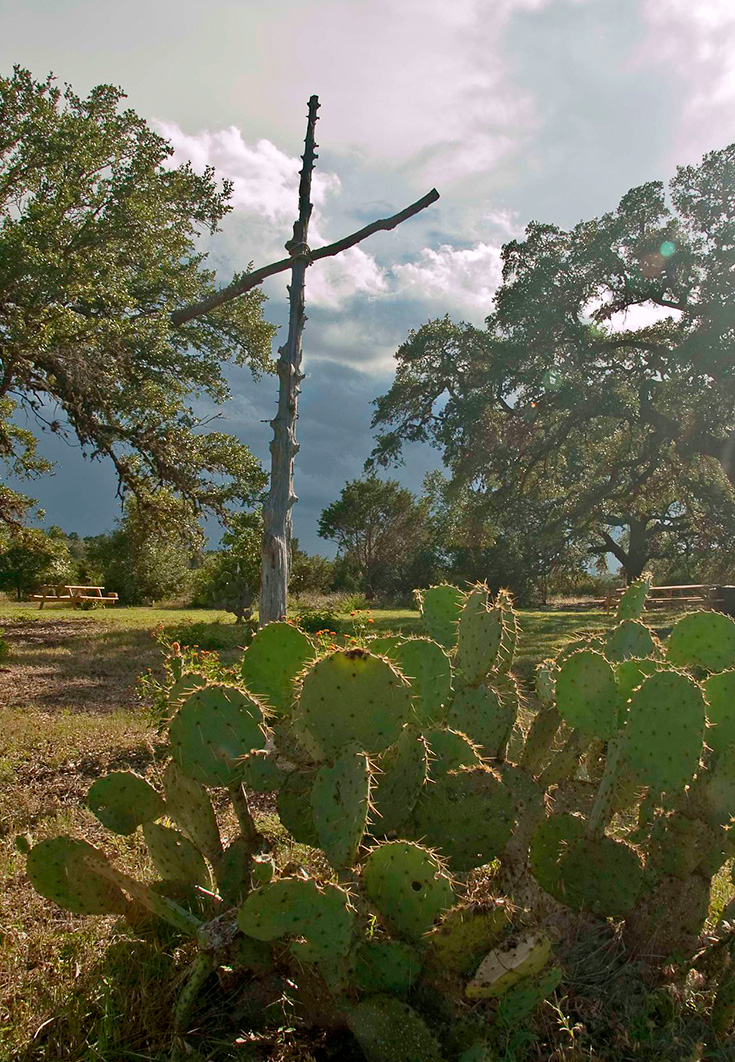Thanksgiving dinner, with everyone seated at the table.
That’s the image that popped into Steve Jones’ head five years ago when a search committee at First Presbyterian Church in San Mateo, California, asked him what intergenerational worship should look like.
“It occurred to me that it should be like Thanksgiving dinner at grandma’s house,” Jones said. “There may be a dish that you may not like, but there will be something that everyone will like. The point is not whether everyone likes all the food. The point is that everybody experiences the dinner together.”
Jones got the job, director of music and worship. Ever since, he’s worked with the church’s pastor and other congregation leaders to serve the needs of everyone at their table. That includes worshippers “of all ages and at all stages,” he said -- children, teens, young adults, middle-agers and seniors.
The goal, Jones said, is to help everyone pray, sing, study the Bible, receive the sacraments and enjoy fellowship in a way that “all are drawn into a fulfilling experience of God’s presence.” To do that, he said, everyone has to show up willing “to give up a little of what they prefer in order to worship together.”
Not every day -- not even every Sunday -- is “grandma’s Thanksgiving dinner” yet at First Presbyterian, but the church has made great strides toward intergenerational worship. Fueled in part by a Vital Worship Grant from the Calvin Institute of Christian Worship, they’ve boosted the participation of all ages at the Sunday service, launched a weeklong children’s camp on worship, started a church-band mentoring program, published a pew booklet on worship and held a churchwide worship workshop.
Together, these and other measures are creating not just a culture of intergenerational worship at First Presbyterian San Mateo but an intergenerational church, said the Rev. Shannon Pappas, the pastor and head of staff.
“We’re trying to be a congregation that loves and appreciates across generations,” Pappas said. “We encourage everyone to meet people of different ages, develop relationships, and to do that in intentional ways outside of worship as well.”
The efforts are starting to pay off, Jones said. Friendships and mutual accountability are developing between young and old. Members of the adult choir have been “adopting” youth choir members, becoming prayer partners and, in turn, modeling intergenerational ministry for the rest of the congregation.
Where generations can mingle
Sure, members still often seek out their contemporaries at services and other events. But more intergenerational mingling is evident, for example, at youth worship nights, worship conferences, picnics and the church’s ministry at a local nursing home, where children, teens and adults sing and visit the patients together, Jones said.
To Annette Tornborg, the congregation’s elder for worship, church is a natural place where generations can mingle.
“A community of Christ is unique in our culture, because it’s the only place where five generations regularly get together,” she said.
Not long ago, some of those generations -- the younger ones -- were starting to disappear from First Presbyterian. When Pappas came to the church in 2008, it was a graying congregation, with membership heavily weighted toward people in their 70s and older.
The focus on intergenerational worship wasn’t so much a choice as a necessity, Pappas said.
“We could have become a church of only older people, but that’s a road to a long, slow passing away,” he said.
Faced with similar demographics, many congregations add a contemporary service to draw in young people. But First Presbyterian took a different path. Instead of offering separate traditional and contemporary services, they sought a middle ground, a single service that drew from both approaches.
“We decided to seek a third path, something between not changing and changing radically,” Pappas said. “We wanted something creative, something faithful, something good that met a variety of perspectives and needs, something relevant to many people across five generations.”
What they got was a blend of traditional and contemporary worship, a mix of stained glass, sacraments and creeds, hands-in-the-air praise songs, videos and a worship band. A typical service might begin with a traditional hymn, followed by a classical choir anthem or a black gospel number, then a choral version of the Newsboys’ latest hit, then back to Bach or Beethoven.
What really sets the service apart
“We’re not trying to prove a point,” Jones said. “We’re trying to illustrate that just as all people have a place in the kingdom, so do different musical styles when presented well.”
But what really sets the service apart are the people leading and participating in it.
“Every Sunday we balance the leadership on the platform to include members of different ages,” Pappas said.

of all ages lead Sunday worship at First Presbyterian.
“We’re making a special effort not only to have people of all ages attend together but also be represented on the platform,” Jones said. “The children are not there to be cute or the seniors as a token. All are valid, and all are accepted.”
About 500 people, including 320 members, participate in the life of the church. Leaders attribute some recent growth to “a terrific children’s department,” but new families seem to be attracted to a church that tries to integrate all generations.
A combined service has its challenges, Jones said. Separate traditional and contemporary services are much easier to plan and execute.
“The most obvious challenge is the fact that younger people and older people enjoy very different music styles,” he said. “Selecting music is a constant balancing act.”
But the congregation may have the biggest challenge.
“The congregation has to approach it with the mindset that they aren’t there to get their own recipe,” he said. “They are there to be with the family and wait until their favorite food comes along. It’s a different mindset and a different paradigm.”
With young people participating in the service, the congregation must also understand the difference between performance and worship. Worship is not the school play or a recital.
“When someone small and cute recites Scripture or sings, people want to applaud, as though it were a performance,” Jones said. “Yet applause can pull people away from the focus of why we are here -- so some teaching goes along with this.”
Building bridges with music
Ironically, music -- the very thing that can so divide young and old -- has been the key to First Presbyterian’s efforts to create intergenerational worship, building bridges across generations.
Members of the adult and youth choirs and bands take part in the weekly service, as do guest musicians from the community. For the past five years, the youth band has also led a weekly Thursday service.

Tornborg echoes the importance of music in intergenerational worship.
“Music helps kids understand lots of things we do in worship,” Tornborg said. “It teaches them about liturgy and about how a worship service is put together.”
By participating in the youth choirs and bands and attending the summer Kids’ Worship Adventure camp -- a weeklong camp that teaches children in grades K-6 the principles of worship -- the church’s young people learn by doing. By middle school or high school, they are skilled enough to be on the platform on Sunday morning.
Evans’ daughters Katie, 15, and Megan, 13, have participated in Sunday worship at First Presbyterian. Both play in the youth and adult bands and have attended and taught music at Kids’ Worship Adventure.
Megan, who plays guitar and ukulele, especially enjoys taking part in the Sunday service. Katie, who plays guitar, said that a highlight of her week is being with band members of all ages.
“It’s good to use my talent to please God and to teach younger students,” she said. “And it’s also good to have teens play music with adults, because we learn from them.”
The young musicians don’t just learn how to play better when they are taught and mentored by older members. During rehearsals, the older musicians share techniques and discuss equipment, but they also share stories about their lives.
“We foster mentoring among members of our bands and vocal groups and our worship team,” Tornborg said. “They are listening and hearing each other, praying for each other and helping each other.”
Worship farm team
Programs such Kids’ Worship Adventure and the music mentoring are like a minor-league “farm team,” cultivating and nurturing a new generation of talent, Tornborg said.
“You have to build a farm team, not leave it to chance that young people will be an active part of the church community,” Tornborg said. “If you want to get youth involved in Sunday morning worship, make them stakeholders.”
Many are already moving up to the big leagues. As members of the youth band have grown up, many have joined the adult band. Jones also mentors young people who stay in the band past high school and feel called to full-time worship ministry.

Instrumental Petting Zoo.
The musical instruction helps train the children as worship leaders and teaches them “to glorify God with their gifts and talent,” Jones said. Each day at camp, the youngsters lead a 30-minute worship gathering, and the week closes with a 45-minute worship service led by children for families and friends.
The church has also worked to educate members and visitors about intergenerational worship, publishing a booklet called “How We Worship Together.” Available in every pew, the booklet explains the importance of having children in worship and describes in simple language each element of the service.
“This book says, ‘Welcome, this is what we believe and this is what we value,’” Tornborg said.
Funding for the booklet came from a Vital Worship Grant from the Calvin Institute of Christian Worship in Grand Rapids, Michigan. The church received the award, for almost $13,000, in mid-2013 and completed the one-year grant cycle a few months ago. Tornborg and Jones served as project directors for the grant.
The money also funded a weeklong visit from Friends of the Groom, a Christian theater company that did a residency at last summer’s Kids’ Worship Adventure. The troupe taught campers -- and later, participants in a churchwide workshop -- how to present Scripture through drama, mime and recitation.
Vital and engaging worship
The Calvin Institute has awarded some 700 Vital Worship Grants to congregations, universities, hospitals, nursing homes and seminaries since 2000. Last year, it awarded $300,000 to nearly 30 organizations. Recipients are not required to use the money for intergenerational worship, though the program does encourage such efforts.
“For worship to be vital and engaging and significant in a healthy church, it’s best that it be inclusive of all generations,” said the Rev. Kathy Smith, the associate director and program manager for grants programs at the Calvin Institute.
Why intergenerational worship?
- It enables each generation to benefit from the wisdom, experience, perspective, enthusiasm, care or love of other generations.
- It lessens the degree to which style preferences separate different age groups and prevent them from focusing on the common ground of their faith.
- It models the body of Christ, the family of God, in which each part or person plays a unique role that supports the others.
- It presents the community of Christ as one that transcends differences in age, background and experience in pursuit of the “big thing,” seeking God.
- It represents a return to the historic mode of Christian worship, with family members worshipping together.
-- From Steve Jones, director of music and worship, First Presbyterian Church, San Mateo.
Church has always included people of all ages with a wide variety of gifts, Smith said. Intergenerational worship is about including the gifts of all in leading and participating in worship.
Beyond the programs that the Vital Worship Grants make possible, there is another benefit that many recipients don’t anticipate, Smith said.
“We’re told all the time that the money helps but that it was the accountability that made a difference,” she said. The grants force recipients to think deeply about their projects and what they are trying to achieve.
Tornborg agreed, saying that the grant gave First Presbyterian vision and focus:
“It gave us intentionality for our vision of intergenerational worship and why it had to be, not a stand-alone effort, but part of a trajectory.”
Those benefits became even clearer last February, when the church held an all-church worship workshop to evaluate how the grant has impacted services and the congregation’s understanding of worship.
Robert Nordling, a former music director at the church and a former professor at Calvin College, led the workshop. About 60 people, from age 11 to 82, attended. If feedback from the participants is any indication, members have learned much about both worship and themselves.
As one participant noted, “We are more alike generationally than we think.”
Even so, much work remains to be done, Jones said.
“First Pres hasn’t ‘arrived’ -- we’re on an ongoing adventure,” he said. “But the overarching lesson is that it is possible for some churches to have a shared family worship experience.”
Just like at Thanksgiving dinner.
Questions to consider
Questions to consider:
- First Presbyterian was intentional about realizing its vision. What intentional steps have you taken to achieve organizational goals?
- Both-and solutions are challenging. What challenges have you faced in creating integrative solutions in your institution or congregation?
- First Presbyterian viewed its youth as “stakeholders.” How is your institution or congregation investing in youth and young adults?
- Implementing integrative solutions requires an educational strategy. What teaching have you done as you have tried to solve problems in new ways?
- How do you build accountability structures in your most important programs or projects?







